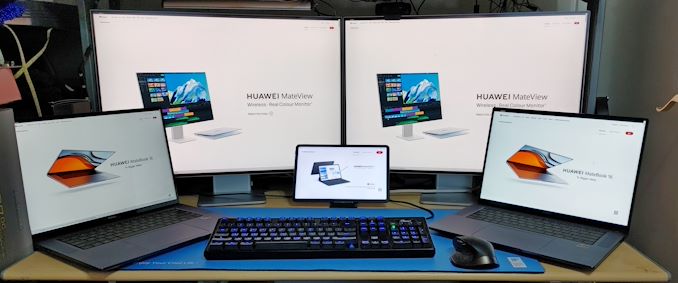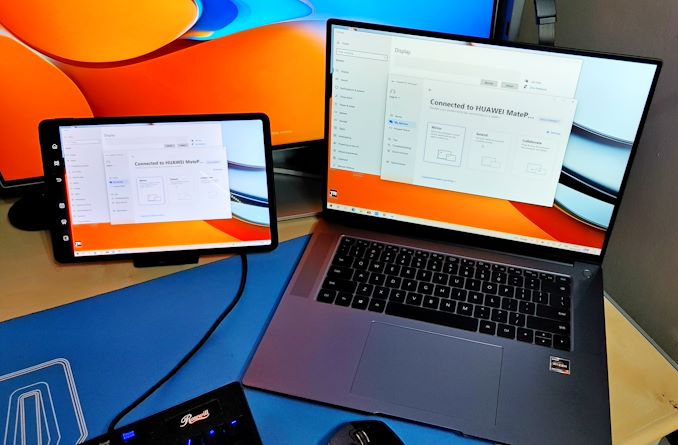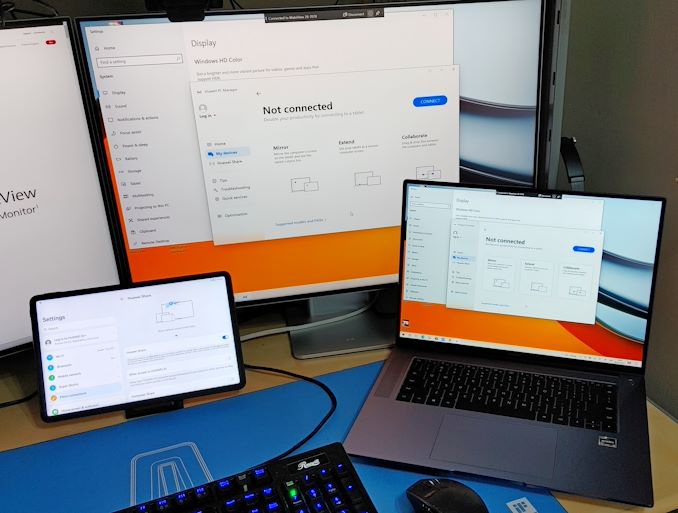The Huawei MateBook 16 Review, Powered by AMD Ryzen 7 5800H: Ecosystem Plus
by Dr. Ian Cutress on October 20, 2021 8:00 AM EST- Posted in
- Laptops
- AMD
- Huawei
- Matebook
- Ryzen
- Zen 3
- MateBook 16
- Huawei Share
- Ryzen 7 5800H
Huawei Share
For the last few generations, the Huawei Share utility was advertised as an easy way to transfer files between a Huawei smartphone and a Huawei laptop. By using the NFC sensor in the phone, and an NFC coil on the right side of the trackpad, a user could ideally wave their smartphone, and the requisite app would load on both devices asking to connect. This functionality eventually expanded to allow the smartphone display to show on the laptop, or the smartphone to be used as an additional touch screen/mouse control for the laptop.
That’s about where it stood before the company was put on the US Entity list. Since then, the opportunity to test the feature’s improvements has been few and far between, partly due to the confusion about where and when devices would come out, but also the global pandemic limited travel, product launches, and demonstrations. Fast forward to 2021, and Huawei’s device portfolio has expanded.
The most notable expansion in my eyes is a push into the monitor market. Huawei now sells two monitors: the MateView, a 28-inch HDR400 monitor at a 3:2 aspect ratio labeled as a 4K+ resolution (3840x2560), and the MateView GT, a 34-inch ultrawide monitor with a 3440x1440 resolution and 165 Hz refresh rate. Both monitors also feature an NFC coil in the base to use with Huawei Share, as well as an intuitive menu system to support wireless connectivity with any non-Huawei supporting device. The MateView displays were recently significantly discounted in the UK over September (£400 after rebate), and unbeknownst to the Huawei PR team here, I purchased two.
The PR team had sent over the latest Huawei Android Tablet, the MatePad 11, to test with Huawei Share. Put this all together, with my Huawei P30 Pro smartphone, and technically everything should work with everything else.
Connecting the laptop to either the smartphone or the tablet works through Huawei Share directly. The tablet allows for screen duplicate, screen expansion, or using the tablet as a mouse for the laptop. Connecting the smartphone shows the smartphone screen on the laptop, so it can be controlled with a mouse/keyboard, as well as take calls and tether to take advantage of any data/Wi-Fi. The laptop control of the smartphone allows for multiple smartphone apps to be open in separate windows, including video playback on YouTube, for example, however any audio played on the smartphone is redirected to the laptop instead.
Connecting to the monitor is slightly different, as it doesn’t go through Huawei Share. This is done with Windows’ own wireless display connectivity. Search for ‘connect to a wireless display’, and it goes through the motions. For some devices it requires activating a feature or two inside Windows, but it takes you through it step-by-step, and then after that it’s quite easy. That being said, there is a couple of drawbacks.
Connecting through Huawei Share is secure, and requires verification on both devices. Connecting to the wireless display does not, and so in an open office environment it requires the devices to be named, as you can take over someone’s device even when they are using it. Also, wireless display connectivity at a distance of 6 feet showcased a small but noticeable input lag. In this environment, the display is best for content that doesn’t require much interaction, such as a static calendar, or a film.
But on the plus side, even though Huawei Share is a single point-to-point connection, using the wireless display through Windows option doesn’t take that away, so you can connect to monitor+smartphone or monitor+tablet at the same time. With the HDMI port, there’s another option for a display, perhaps with better input lag as well. Although with all these displays, some being driven through the CPU rather than the GPU, it will start to put a load on the system.
As part of this review process, I ended up with two MateBook 16 devices. The charger on my first one was effectively DoA, so instead of sending me a separate 135W charger, the PR team just sent a full laptop. I was intrigued if I could connect both laptops together – and technically I could through the wireless display feature! While this is really quite pointless, it was a fun activity.
I would say that there is one limitation – I could only connect to one device through Huawei Share at a time. For example, I could not connect to the tablet and the smartphone at the same time – it was one or the other. This is likely down to only having one point-to-point connection available, as more would require battery/cost/weight. Ultimately at some point in Huawei’s future I imagine there to be a dock for multiple devices to be connected to, some wired, others wireless.














87 Comments
View All Comments
TheinsanegamerN - Wednesday, October 20, 2021 - link
Good to see another company jump on the "use a 45w ryzen chip without a dGPU" train, letting that iGPU stretch its legs a bit mroe. Shame it limits TDP so much, the mechrevio1 is a similar laptop that doesnt do that, rather allows up to 54 watt. But the huwaei has that gorgeous 16:10 display.....We need mroe of these types of laptops, and less of the dell/HP/lenovo garbage weve been getting.
at_clucks - Thursday, October 21, 2021 - link
We would have had a Kirin M1-like CPU soon if Huawei wasn't targeted by the restrictions on using US tech. Somehow those restrictions don't apply when buying straight up from Qualcomm or AMD, only when competing with them.So while I love to see mobile devices based on AMD CPUs, I would very much have loved even more to see a proper ARM SoC in there, giving M1 a run for its money. SOmething that's not tied to MacOS for example. And no, I don't consider ARM Surfaces to be that.
Arsenica - Thursday, October 21, 2021 - link
Nah, Huawei only licensed IP cores straight from ARM.At most they would have an Exynos 2000 equivalent (Cortex X1 and Mali G78 cores).
blanarahul - Wednesday, October 20, 2021 - link
"I’m a fan of notebooks that promise good power and battery life at the expense of graphics.""I have some software in my daily toolset that doesn’t work on either, so until then, I’m still focused on devices built with AMD or Intel."
Cannot agree more. I recently got a gaming notebook and while having a discrete GPU is nice, having a modern processor that is allowed to consume up to 30-40 watts and strech its legs makes a world of difference in terms of responsiveness in the applications I need to use on a day to day basis (which cannot run on Linux or Mac).
I wonder what difference Alder Lake will make with its 6 P + 8 E cores design to responsiveness and battery life.
Alistair - Wednesday, October 20, 2021 - link
and yet I've been trying to sell my top of the line CPU laptop (Ryzen 4800H) for $650 (it has a 1650 ti) and you'll find nobody wants it, I think gaming has taken over the vast majority of the market, CPU aficionados tend to have less computer knowledge, and think any Intel quad core is the same as an AMD 8 coreMccaula718 - Wednesday, October 20, 2021 - link
Your Zen 2 cpu is not top of the lineat_clucks - Thursday, October 21, 2021 - link
That's not really the problem, it's close enough to it when it comes to AMD's mobile lineup. But most people have no brand awareness when it comes to AMD, and Intel has a much more powerful brand that will attract regardless of actual performance standing, even price. And futhermore, these days a 5 year old decent laptop still does the job fine for regular day to day things. So the market for midrange new laptops (meaning not cheap low end, not superfast high end) might be smallish.You can't get a proper PC GPU so you go for the next best with a mobile GPU where the whole device is still cheaper than the PC GPU. Or you get a cheap laptop that does browsing and the likes. The offer presented above is smack in the middle.
Alistair - Thursday, October 21, 2021 - link
the 4800h was the best CPU you could buy a year ago, now it is second best, yes it isblanarahul - Thursday, October 21, 2021 - link
In my entire social circle, I am the only one who knows AMD makes excellent CPUs and GPUs as well. They all think Intel is the only one who makes CPUs (for laptops) and Nvidia is the only one that makes dGPUs. They find AMD to be "sketchy". It is upsetting but it is what it is.AMD needs to succeed in consoles and workstation/server market because as much as I hate it, Windows + Intel + Nvidia is just too powerful a combo (in terms of market presence) in the mainstream consumer market.
Alistair - Thursday, October 21, 2021 - link
exactly, that's the problem, someone actually thinks the 11400h is faster than the 4800h for example :/